Progressive Palaeontology (ProgPal) is an annual event where early career researchers get to demonstrate their research to an equivalent audience in a reasonably informal atmosphere. It’s also renowned as a mega p*ss-up, as everyone knows palaeontologists are chronic alcoholics (hence the dinosaurs with feathers hypothesis). This year, it was in the vibrant and cosmopolitan northern UK city of Leeds. Some of the research communicated there was pretty freaking sweet. You can find recordings of all of the talks on Palaeocast (at some point in the future), and the Twitter feed was #progpal if you want to see a historical live version of the event.
For me, it was a chance to catch up with some buddies in the field (Imperial College is quite devoid of palaeontologists), and hear what the latest developments in the field were. As a member of Palaeocast, it was also a chance for us to test our live-stream capabilities (great success!), and broadcast some awesome science to those outside of the conference.
The sessions were divided into four themes: reconstructing life habits; palaeoenvironments; vertebrate evolution; and exceptional preservation. It all started off pretty much with everyone complaining about how hungover they were, following the epic ice-breaker the night before and a storm of Belgian beer, and generally being furious about the lack of morning coffee.
Life habits
So the opening session was a bit of a blinder (in no way biased by the fact that my presentation was part of it). Reconstructing ancient modes of life and ecologies is one of the most difficult tasks palaeontologists face, as obviously observations of life is impossibru for fossils. Robert Lemanis kicked things off discussing the mechanics of buoyancy in ammonites compared to their extant analogue, the Nautilus. CT-scanning (also making an appearance later in David Button’s talk) was used to generate 3D models of ammonites, including all their internal nasty parts (mostly empty chambers – all the tasty stuff decayed millions of years ago), and showed that the buoyancy parameters changed during ontogeny (developmental growth) which may have influenced which part of the water column these ancient critters lived.
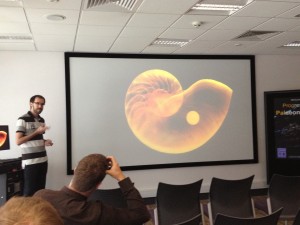
A head-scratchingly good 3D model of a Nautilus – 3D seems to be all the rage these days, for some bizarre reason.. (click for larger)
Laura McLennan followed this with a pretty awesome talk on modelling the feeding ecology in extant sharks, in the hopes of developing a model that we can use to determine what ancient sharks ate (shells, fish, other sharks, children), which may provide a rigorous ecological factor to compare to their historical diversity. Laura described the pinnacle of her research as “in progress”.
My talk was next on some research I’ll be publishing soon, and will write up a more comprehensive blog post to accompany the article closer to the time.
David Button, sauropod wizard, claims that he found “evidence of differential biomechanical partitioning relating to ecological specialisation in sympatric [co-occurring] dinosaurs; which is nice in a clade where cranial complexity is often overlooked”. A method called finite element analysis, often used in engineering, can be used to look at the variations in stress between skull bones, and you can even map muscles on to the skulls if you can identify where the attachment points were. Using two well-known sauropods, Camarasaurus and Diplodocus, both from the Upper Jurassic of North America, David showed that the two had different stress distributions within their skulls, and that Camarasaurus may have been a more generalised forager. Kind of like a PhD student.
Palaeoenvironments
The evolution of past climates and environments is essential for understanding how they will respond in the future, and providing baseline models for ‘natural’ variations.
Alexandra Lee kicked off the session with her investigation into how angiosperms, or flowering plants, first originated and in what kind of habitats. Molecular data using modern angiosperms actually is not in concert with what we know from fossils, so determining the precise date of their origin is a bit of a mystery at the moment. It has actually been suggested that the onset of more advanced feeding mechanisms or increasing biodiversity in dinosaurs drove the initial angiosperm radiation, so will be interesting to see how this research plays out in the future. Here, Alexandra developed a new model that showed that early species of angiosperms had the capacity to adapt within many different types of environment, including those either shaded or in full sun. It provides another piece to the ever-developing puzzle of angiosperm origins.
We then time-warped into the Pliocene, much closer to our time, to look at what ancient soils can tell us about past climates, and filter that into how we predict future aspects of climate change. Matthew Pound developed a new model that explained regional changes in the local climate and vegetation, providing important details on the feedbacks that climate change can have, particularly in areas like North America and southern North Africa.
Nicola Clark took us on a historical tour of some of the fossils mentioned in Charles Darwin’s logs of his travels on The Beagle, namely huge molluscan assemblages down the coast of South America. These fossils contain a huge wealth of palaeoclimate data, particularly about seasonal variations in the East Pacific during the Neogene period. Preliminary data suggests that the climate state during the Pliocene was much warmer than modern times.
Vertebrate evolution
The afternoon session kicked off with a ‘mini-symposium’ on vertebrate evolution. Quite a hot topic, given that it deals with everything from dinosaurs to us!
Joe Keating, co-producer of Palaeocast, gave a lovely account of his early PhD research into early vertebrate skeleton development. He’d used techniques ranging from standard optical microscopy all the way through to x-ray synchrotron tomography (hardcore – pretty much a particle accelerator). Looking at ancient fossils, he was able to develop an image of the development of bone, as a series through developmental growth. Plenty of scope for developing this with other primitive vertebrate groups, such as jawless fishes.
The link between dinosaurs and birds is one of the most stunning tales in evolution, ever. Mark Puttick described modelling work he’d conducted as part of his PhD on the relationships between bird-line dinosaurs (Maniraptora) and more derived birds (Paraves). Rather awesomely, he found a huge difference in the rates of body size evolution between the two groups, and a transition in the relationship between forelimb and hindlimb length which probably relates to new adaptive functions as birds began to take to the skies.
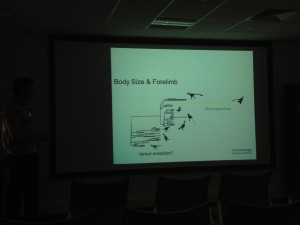
Mark demonstrating some of his comparative evolution skills off between dinosaurs and birds (click for larger)
Sticking with the big guns, Gabi Sobral dug deep into early tetrapod relationships (Neodiapsida), picking apart some of the issues we have (hint: there are many) in accurately reconstructing the relationships between some of these enigmatic species. Luckily, CT scanning comes to the rescue again! (palaeontologists are great at stealing techniques from other sciences – “multi-disciplinary”..) Gabi CT scanned the skulls of some wild-card taxa, such as Elachistosuchus huenei from the Triassic of Germany, to have a look at the morphology of the braincase and see what new information this can provide. Gabi thinks that the biggest issues we face with reconstructing neodiapsid (the non-mammal line of reptiles) phylogeny from fossils are “people choosing clade occupation before running analyses properly which biases taxa selection, and that people have been using the same characters on this since about the 1980s, when really a lot of revision is needed.”
Taking it back to the seas, Tom Stubbs explored the radiation of marine reptiles (things like ichthyosaurs, placodonts and plesiosaurs) during the Triassic period. What he found was that morphological diversity and biological diversity were largely decoupled throughout the Triassic: “you find a relatively rapid proliferation of lower jaw shapes early in the Triassic, but the maximum levels of disparity are found in the Carnian when the diversity was in decline.”
Exceptional preservation – it’s gut instinct
Sometimes, the fossil record gives us mind-blowingly awesome glimpses into lost worlds ancient ecosystems and the organisms that lived in them. These are termed fossil lagerstatten, and represent rare cases of exceptional preservation, with intricate details of soft tissues usually preserved.
Peter Adamson took us on journey into the murky Precambrian world of acritarchs – these are enigmatic li’l microfossils, with a pretty complex evolutionary history. There was also an acritarch shaped like a guitar. Awesome. Congrats to Peter too for winning the best talk of the conference! Acritarchs are actually organic-walled microfossils, and at the moment palaeontologists have no idea where they fit into the tree of life. I asked Peter why acritarchs are important for palaeontologists, and he replied quite soberly saying that “they’re probably the only fossils we can use to confidently assess biostratigraphy during the early Ediacaran [the period just before the Cambrian 635-541 million years ago]”.
We skipped over to Greenland after, with Katie Strang looking at fossils associated with the Cambrian Explosion with exquisite soft-bodied preservation. These fossils were from the Sirius Pass (why so Sirius?), and may be comparable in the way they’re preserved to the infamous Burgess Shale locality. Rather neatly, this combines aspects of geology to determine the depositional setting that the fossils would have lived in. Combined with geochemistry, Katie explored the elemental distribution of rock samples here to decode how the fossils there are so beautifully preserved. We also finally got a question from Twitter at this point, from the USA!
We went to a place where I grew up afterwards, to Charnwood Forest in Leicestershire (I didn’t grow up *in* the forest), looking at what some of the bizarre Ediacaran fossils from there are – a picture complicated by the lack of modern analogues, and preservation as impressions in the rocks. Charlotte Kenchington led us through the bewildering array of forms, things which resemble ferns and bushes, dumbbells, and even Basil Brush! Another researcher, Renee Hoekzema, is assessing patterns of their morphospace, and thinks that there may be more to their ecological complexity than a superficial analysis may reveal..
Time ticked by ludicrously fast, and all of a sudden we were at the final talk!
Oliver Knevitt gave an account of how the manner in which types of fossils decay affects how we interpret them in terms of their evolutionary relationships. It was pretty terrifying, as when you look at how types of crustacean (phyllocarids) rot over time, the way in which they preserve different aspects of their bodies change, and particularly with respect to evolutionarily significant characters. I asked Oliver why he decided to study the decay of fossils: “it’s a completely overlooked aspect of fossils – we forget that these were once animals and carcasses before actually becoming fossils. If we want to find out how the fossil is linked to original organism, it’s imperative that we understand how rotting affects our impression of it.”
And there you have it! The latest hot-of-the-press palaeontology from aspiring Dr. Alan Grants, and hopefully a flavour of what’s to come in the news over the next few months. I guess if any of these snippets sound interesting to you, the researchers will be more than happy to go into more detail should you wish to contact them.

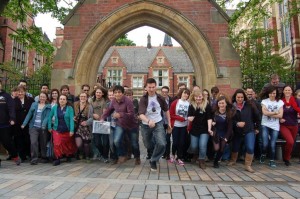
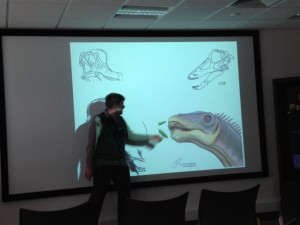

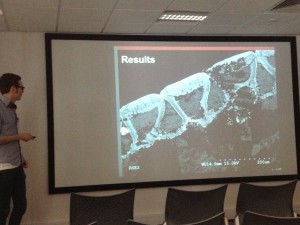
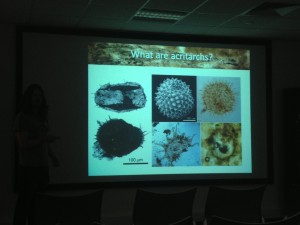
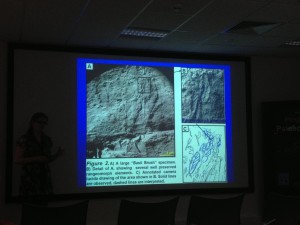

Mark Martens
I’d like us to meet at the upcoming OBR event on Thursday.
mark hcg martens
accidental scientist
Jon Tennant
Sure, I’ll be there – just come say hi! 🙂